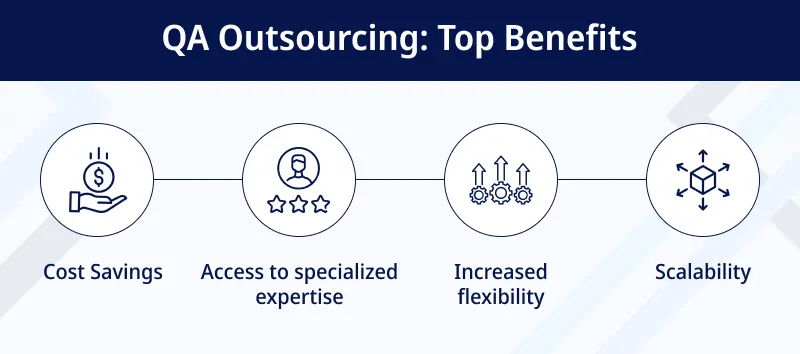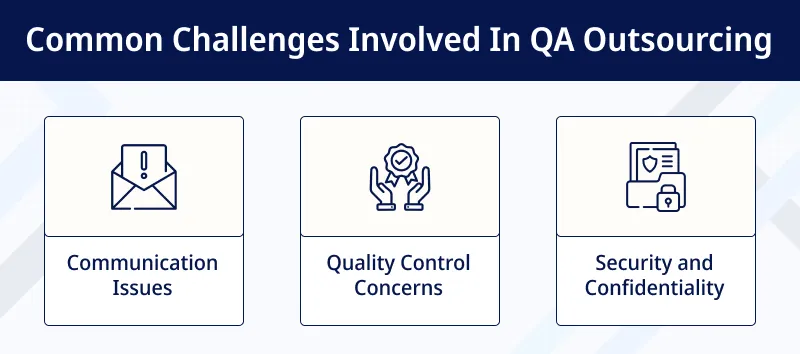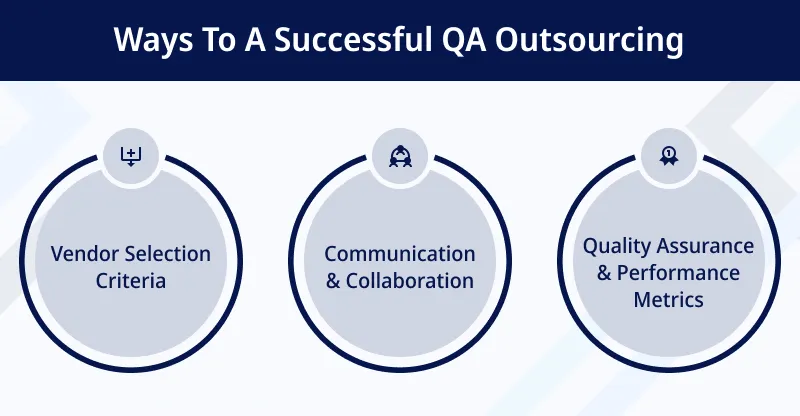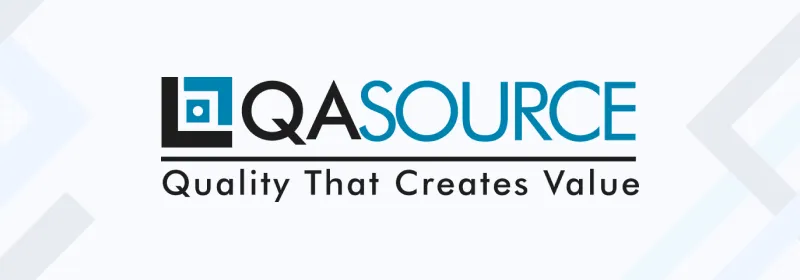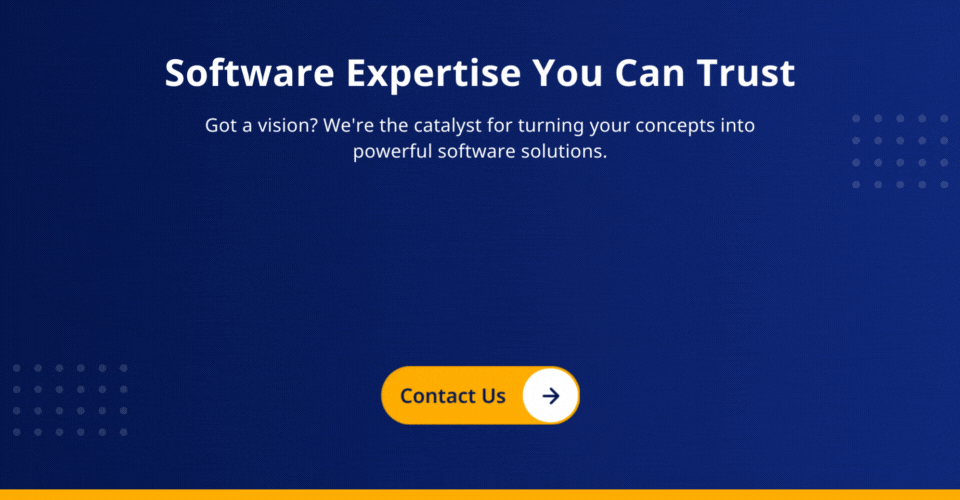Are you constantly struggling to maintain high-quality software while dealing with tight deadlines & limited resources?
If it is so, you are not alone.
Businesses today are being confronted with a surge in demand to present perfect products that satisfy their customers’ needs.
As a result, Quality Assurance outsourcing, an intelligent approach that guarantees to lessen the difficulties associated with on-site testing, has become increasingly popular.
In this blog post, you will embark on a detailed journey of cost-benefit analysis of QA outsourcing, covering its advantages & potential drawbacks and ultimately determining whether it is a worthwhile investment for your organization.
QA Outsourcing: An Overview
Many companies often face the challenge of maintaining an in-house QA team due to various reasons such as cost, expertise, and scalability. This is where QA outsourcing comes into play.
QA is an essential aspect of software development that ensures the delivery of reliable & bug-free products. QA outsourcing involves partnering with external vendors or specialized firms to handle these testing & quality assurance processes.
It offers several benefits:
- Cost savings
- Access to specialized expertise
- Increased flexibility
- Scalability
So, you can also hire software testing teams to get accurate software products.
Unlock efficiency and quality through outsourcing.
Drawbacks and Challenges of QA Outsourcing
QA outsourcing often comes with some disadvantages & challenges which need to be aware of before deciding on it.
Let’s look below:
Communication Issues
Language barriers & time zone differences are common communication issues of QA outsourcing.
To avoid this:
- Ensure effective communication channels to bridge language gaps. This involves hiring translators or utilizing communication tools that support multilingual conversations.
- Establish clear communication protocols and set expectations regarding response times to minimize delays and ensure smooth project execution.
Quality Control Concerns
Maintaining and aligning consistent QA standards with project goals can be a significant challenge when outsourcing QA.
To avoid:
- Establish a robust quality control process with clear guidelines, documentation, and regular feedback loops.
- Ensure the outsourced team understands the project requirements and delivers work that meets the desired quality standards.
- Monitor and measure the quality of outsourced QA work.
- Implement effective strategies that involve conducting regular audits, performing thorough reviews of deliverables, and utilizing automated testing tools.
Security and Confidentiality
Security and confidentiality are paramount concerns of QA outsourcing.
To avoid:
- Implement robust data protection measures
- Establish non-disclosure agreements (NDAs)
- Ensure that the outsourcing partner adheres to strict security protocols
- Evaluate the outsourcing partner’s security protocols
- Conduct thorough background checks
Moreover, by selecting a reliable software outsourcing services provider focusing strongly on security, you can mitigate the risks associated with data breaches & maintain confidentiality.
Also read: Advantages Of Outsourcing Software Testing Services
Benefits of QA Outsourcing
Software QA & testing services benefit companies striving to deliver high-quality products while optimizing costs.
Look at the three significant benefits of QA outsourcing below:
Cost Savings
QA outsourcing services allow companies to leverage the expertise of external teams without incurring any upfront costs.
- Avoid investing in expensive testing infrastructure
- Access to state-of-the-art tools and technologies
- Eliminate the need for extensive training programs & recruitment efforts
Access to Expertise
QA outsourcing provides access to specialized skill sets that may be available in various ways.
- Experienced professionals bring a fresh perspective & identify potential issues
- Well-versed in industry best practices & possess domain knowledge
- Stay updated with the latest trends, software technologies & regulatory requirements
- Ensure that the software meets the best quality standards
- Enhance the overall quality of the products & gain a competitive edge
Scalability & Flexibility
QA outsourcing allows companies to adjust the size of their QA team based on project requirements. Additional QA resources can be quickly allocated during peak workloads or when multiple projects run simultaneously.
- Ensures that testing is not a bottleneck in the development process
- Helps meet project deadlines effectively
- Quickly ramps up or down the QA resources as needed
- Ensure that the testing process remains efficient & uninterrupted
Experience cost-effective QA outsourcing solutions.
Performing Cost-Benefit Analysis
When considering QA outsourcing, a thorough cost-benefit analysis is essential to determine its viability for your organization.
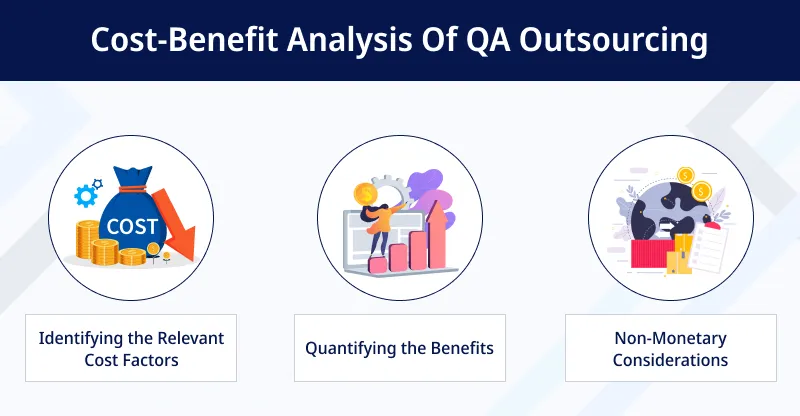
Breaking down the costs associated with in-house QA
The costs associated with maintaining an in-house QA team include:
- Salaries and benefits of QA professionals
- Infrastructure expenses, viz. hardware, software, testing tools
- Training and development programs
- Management overhead
Analyzing the pricing models of QA outsourcing vendors
Different vendors may have varying pricing structures, such as hourly rates, fixed project-based pricing, or dedicated team pricing.
Consider factors
- Scope of work
- Level of expertise provided
- Any additional costs
- Vendor’s reputation, experience & track record
- Level of support and communication
Remember to consider the financial aspects and the value and expertise that IT outsourcing services can bring to your QA processes.
2. Quantifying the Benefits
Assigning monetary value to the benefits of outsourcing
Assigning a monetary value to each benefit is essential to assess the benefits of QA outsourcing accurately.
Hence, you can start by considering the potential cost savings achieved through QA outsourcing, such as
- Reduced infrastructure expenses
- Training costs
- Recruitment efforts
Now, estimate the amount of money that would have been spent if the QA activities were performed in-house. This provides a tangible value for the cost savings achieved through outsourcing.
Additionally, consider the value of accessing specialized expertise and industry best practices.
While assigning a precise monetary value to these benefits may be challenging, you can estimate their impact on revenue generation, customer satisfaction, and overall business success.
Comparing the ROI of In-house QA vs. QA Outsourcing
Once you have quantified the benefits, comparing the ROI of in-house QA v/s outsourcing becomes essential.
Calculate the ROI for both scenarios by dividing the net benefits (benefits minus costs) by the total costs incurred. This calculation compares the financial returns derived from in-house QA and outsourcing.
Consider other qualitative aspects, such as the potential for innovation, scalability, and flexibility that outsourcing can offer.
These factors may not have a direct monetary value but can contribute significantly to your organization’s success and growth.
3. Non-Monetary Considerations
Assessing intangible benefits such as faster TTM & enhanced quality
While monetary benefits are crucial, evaluating the intangible benefits of QA outsourcing is equally essential.
Consider the potential for faster time-to-market that outsourcing can offer. For this,
- Streamline the offshore software testing process
- Identify & resolve issues more efficiently
- Accelerate product releases
External QA teams’ expertise can help identify potential issues & improve the overall quality of your software. This can reduce customer complaints, enhance brand reputation, and increase customer loyalty.
Addressing potential risks & their impact on the overall analysis
It is critical to address potential risks associated with QA outsourcing and evaluate their impact on the overall cost-benefit analysis. Risks may include.
- Communication challenges
- Lack of control over the QA process
- Potential data security concerns
- Dependency on external vendors
Assess the likelihood & potential impact of these risks on your organization.
Consider implementing risk mitigation strategies, such as
- Establishing clear communication channels
- Conducting thorough vendor evaluations
- Implementing robust security measures
By addressing these risks proactively, you can minimize their impact and maximize the benefits of QA outsourcing.
Further reading: Red Flags In Software Outsourcing: 7 Warning Signs You Can’t Ignore
Best Practices for Successful QA Outsourcing
When considering QA outsourcing, selecting the right vendor is crucial for a successful partnership.
However, the vendor selection process requires careful consideration and thorough research to ensure that the chosen outsourcing partner aligns with your organization’s goals and requirements.
1) Vendor Selection Criteria
When selecting a QA outsourcing partner, it is essential to consider several key factors. These include.
- Vendor’s experience & expertise in QA
- Track record of successful projects
- Understanding of your industry & domain
- Ability to meet your specific requirements
- Vendor’s Reputation
- Financial stability
- Cultural compatibility
By identifying and prioritizing these criteria, you can create a comprehensive vendor selection framework.
Moreover, conducting thorough research & due diligence is essential to ensure a successful QA outsourcing engagement.
- Start by gathering information about potential vendors through online research, industry referrals, and client testimonials.
- Evaluate their expertise, certifications, and the technologies they specialize in.
- Consider their communication capabilities, responsiveness, and ability to adapt to your organization’s working style.
- Conduct interviews or meetings with shortlisted vendors.
- Request case studies or references from their previous clients
This due diligence process will help you make an informed decision & select a vendor that best aligns with your organization’s needs.
2) Communication & Collaboration
Clear & open lines of communication between the outsourcing company and the QA team are essential for smooth collaboration and efficient project management. This can be achieved by using various communication tools, such as:
- Instant messaging platforms
- Video conferencing
- Project management software
Regular communication helps in addressing any concerns, clarifying requirements, and providing timely updates on the project’s progress.
Additionally, project managers should encourage open communication and collaboration among team members. They should create an environment where team members feel good sharing their ideas, concerns, and suggestions.
Further reading: A Complete Guide On “Software Quality Assurance
3) Quality Assurance & Performance Metrics
It is essential to clearly define the QA objectives before embarking on the outsourcing journey as it aligns with your business goals. These objectives should be SMART, i.e.
- Specific
- Measurable
- Achievable
- Relevant
- Time-bound
In addition to setting objectives, it is equally important to establish performance indicators that will help measure the effectiveness of the outsourced QA process. These indicators include metrics such as:
- Defect density
- Test coverage
- Test execution time
- Customer feedback
To monitor the progress and performance of the outsourced QA activities, it is crucial to implement robust tracking and reporting mechanisms. Tracking mechanisms include tools for:
- Bug tracking
- Test case management
- Test execution monitoring
Regular reporting intervals viz. weekly or monthly, provide an opportunity to review the QA performance against the defined objectives and make necessary adjustments if required.
Transform your testing process for better results.
List Of Companies Benefited From QA Outsourcing
When considering QA outsourcing, examining real-life examples or case studies of companies that have successfully benefited from this approach will be helpful.
By exploring their success stories, you can gain valuable insights into the advantages and outcomes of QA outsourcing.
ValueCoders
It is a leading software development firm established in 2004 and used to outsource its QA activities to a specialized vendor. By doing so, they can tap into the vendor’s expertise and industry best practices.
Their external QA team identified critical issues that were missed by the in-house team, resulting in improved product quality. As a result, they experienced a significant reduction in customer complaints and increased customer satisfaction.
The outsourcing engagement also allowed ValueCoders to focus more on core development activities, leading to faster time-to-market and increased revenue.
QASource
The company faced challenges scaling its QA resources to meet growing demands. They decided to outsource their QA activities to a vendor with a flexible resource model.
This allowed them to quickly ramp up or down the QA team size based on project requirements. As a result, they could manage peak workloads efficiently and meet tight deadlines.
The scalability and flexibility provided by the outsourcing partner enabled QASource to focus on business growth & achieve a competitive edge in the market.
QAWolf
The company sought to enhance the security and compliance of its software. They partnered with a QA outsourcing vendor that specialized in security testing and had experience in the healthcare domain.
The external QA team conducted thorough security assessments, identified vulnerabilities, and provided recommendations for improvement. This proactive approach helped them strengthen their software’s security, ensuring compliance with industry regulations.
The outsourcing engagement improved the product’s reliability and enhanced the company’s reputation and customer trust.
Read this blog: Comparing Software Outsourcing Services: Platforms, Companies, And Freelancers
Conclusion
After conducting a comprehensive cost-benefit analysis, it becomes evident that Software QA & testing services can be a worthwhile investment for businesses.
While there are certain challenges and considerations to remember, such as communication barriers and potential quality issues, the benefits often outweigh the drawbacks.
By outsourcing QA, companies can tap into specialized expertise, reduce costs, improve efficiency, and focus on their core competencies.
Ultimately, outsourcing QA should be based on thoroughly evaluating each organization’s needs and circumstances.
With careful planning and effective management, outsourcing QA can be a strategic move that drives success and growth in today’s competitive business landscape. Moreover, you can hire software QA testers from a reliable QA outsourcing partner like ValueCoders to get the desired results.

